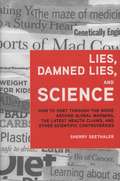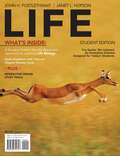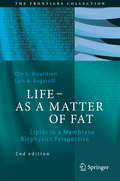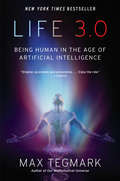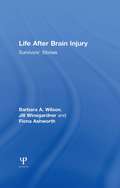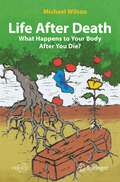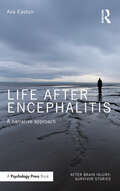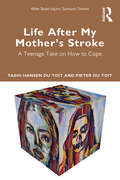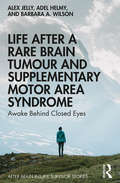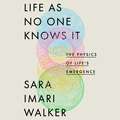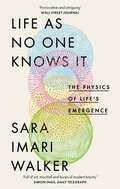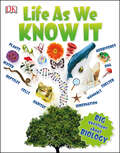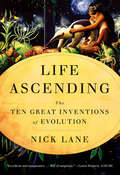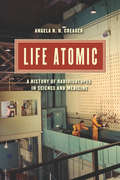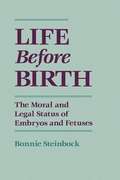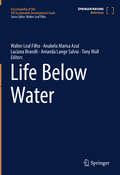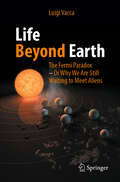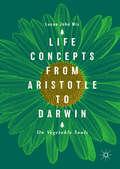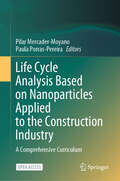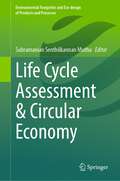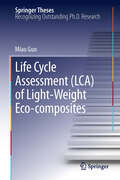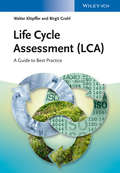- Table View
- List View
Lies, Damned Lies, and Science: How to Sort Through the Noise Around Global Warming, the Latest Health Claims, and Other Scientific Controversies
by Sherry SeethalerDon't get hoodwinked: make sense of news. . . and make smarter decisions for yourself, your family, and the world! Objective, balanced techniques for thinking about everything from diet and drugs to climate change. Identifying and getting past the biases of politicians, lobbyists, marketers. . . and even some scientific and medical professionals. By scientist Dr. Sherry Seethaler, one of the world's most respected and innovative science educators.
Life
by John H. Postlethwait Janet L. HopsonCreated through a "student-tested, faculty-approved" review process, LIFE is an engaging and accessible solution to accommodate the diverse lifestyles of today's learners. LIFE provides streamlined chapters, in-text support, and online tools to make learning more flexible.
Life - As A Matter Of Fat
by Ole G. Mouritsen Luis A. BagatolliThe present book gives a multi-disciplinary perspective on the physics of life and the particular role played by lipids (fats) and the lipid-bilayer component of cell membranes. The emphasis is on the physical properties of lipid membranes seen as soft and molecularly structured interfaces. By combining and synthesizing insights obtained from a variety of recent studies, an attempt is made to clarify what membrane structure is and how it can be quantitatively described. Furthermore, it is shown how biological function mediated by membranes is controlled by lipid membrane structure and organization on length scales ranging from the size of the individual molecule, across molecular assemblies of proteins and lipid domains in the range of nanometers, to the size of whole cells. Applications of lipids in nanotechnology and biomedicine are also described. The first edition of the present book was published in 2005 when lipidomics was still very much an emerging science and lipids about to be recognized as being as important for life as proteins, sugars, and genes. This significantly expanded and revised edition takes into account the tremendous amount of knowledge gained over the past decade. In addition, the book now includes more tutorial material on the biochemistry of lipids and the principles of lipid self-assembly. The book is aimed at undergraduate students and young research workers within physics, chemistry, biochemistry, molecular biology, nutrition, as well as pharmaceutical and biomedical sciences. From the reviews of the first edition: "This is a highly interesting book and a pleasure to read. It represents a new and excellent pedagogical introduction to the field of lipids and the biophysics of biological membranes. I reckon that physicists and chemists as well as biologists will benefit from this approach to the field and Mouritsen shows a deep insight into the physical chemistry of lipids. " (Göran Lindblom, Chemistry and Physics of Lipids 2005, vol. 135, page 105-106) "The book takes the reader on an exciting journey through the lipid world, and Mouritsen attracts the attention with a lively style of writing . . . . a comprehensive view of the 'lipid sea' can be easily achieved, gaining the right perspectives for envisaging future developments in the nascent field of lipidomics. " (Carla Ferreri, ChemBioChem, Vol. 6 (8), 2005)
Life 3.0: Being Human in the Age of Artificial Intelligence
by Max TegmarkNew York Times Best SellerHow will Artificial Intelligence affect crime, war, justice, jobs, society and our very sense of being human? The rise of AI has the potential to transform our future more than any other technology—and there&’s nobody better qualified or situated to explore that future than Max Tegmark, an MIT professor who&’s helped mainstream research on how to keep AI beneficial. How can we grow our prosperity through automation without leaving people lacking income or purpose? What career advice should we give today&’s kids? How can we make future AI systems more robust, so that they do what we want without crashing, malfunctioning or getting hacked? Should we fear an arms race in lethal autonomous weapons? Will machines eventually outsmart us at all tasks, replacing humans on the job market and perhaps altogether? Will AI help life flourish like never before or give us more power than we can handle? What sort of future do you want? This book empowers you to join what may be the most important conversation of our time. It doesn&’t shy away from the full range of viewpoints or from the most controversial issues—from superintelligence to meaning, consciousness and the ultimate physical limits on life in the cosmos.
Life After Brain Injury: Survivors' Stories (After Brain Injury: Survivor Stories)
by Barbara A. Wilson Jill Winegardner Fiona AshworthThis is the first book of its kind to include the personal accounts of people who have survived injury to the brain, along with professional therapists' reports of their progress through rehabilitation. The paintings and stories of survivors combine with experts' discussions of the theory and practice of brain injury rehabilitation to illustrate the ups and downs that survivors encounter in their journey from pre-injury status to insult and post-injury rehabilitation. Wilson, Winegardner and Ashworth's focus on the survivors' perspective shows how rehabilitation is an interactive process between people with brain injury, health care staff, and others, and gives the survivors the chance to tell their own stories of life before their injury, the nature of the insult, their early treatment, and subsequent rehabilitation. Presenting practical approaches to help survivors of brain injury achieve functionally relevant and meaningful goals, Life After Brain Injury: Survivors’ Stories will help all those working in rehabilitation understand the principles involved in holistic brain injury rehabilitation and how these principles, combined with theory and models, translate into clinical practice. This book will be of great interest to anyone who wishes to extend their knowledge of the latest theories and practices involved in making life more manageable for people who have suffered damage to the brain. Life After Brain Injury: Survivors’ Stories will also be essential for clinical psychologists, neuropsychologists, and anybody dealing with acquired brain injury whether they be a survivor of a brain injury themselves, a relative, a friend or a carer.
Life After Death: The Evidence
by Rick Warren Dinesh D'SouzaUnlike many books about the afterlife, Life after Death makes no appeal to religious faith, divine revelation, or sacred texts. Drawing on some of the most powerful theories and trends in physics, evolutionary biology, science, philosophy, and psychology, D'Souza shows why the atheist critique of immortality is irrational and draws the striking conclusion that it is reasonable to believe in life after death. He concludes by showing how life after death can give depth and significance to this life, a path to happiness, and reason for hope.
Life After Death: What Happens to Your Body After You Die? (Springer Praxis Books)
by Michael WilsonDeath is not an end – it’s a new beginning. After death, all of the molecules that came together to form the living “you” become nutrients for millions of creatures, large and small. Your body becomes the hub of a complex ecosystem of microbes, insects, worms, plants and more. Cheer up! This book shows how you are going to live forever – as components of so many other wonderful creatures. It describes the science behind the remarkable recycling of your body. We begin with lessons about how your body functions, is a collection of valuable nutrients and is a home to millions of microbes. The book goes on to describe the various stages the body passes through as it decomposes following death. The microbes and insects that make use of your tissues are then introduced. Finally, you will learn about the enduring effects that your body will have on the wider biosphere. We are rich in valuable resources that will end up feeding an immense number and variety of other creatures. Inevitably, your body will support the continuation of life on our beautiful planet – this book describes how all this happens.
Life After Encephalitis: A Narrative Approach (After Brain Injury: Survivor Stories)
by Ava EastonEncephalitis is a devastating condition whose impact upon people should not be underestimated. It robs people of abilities most of us take for granted, it leaves people without their loved ones, and even in those families where the person affected survives the person they once knew can be dramatically changed. Life After Encephalitis provides a unique insight into the experiences of those affected by encephalitis, sharing the rich, perceptive, and often powerful, narratives of survivors and family members. It shows how listening to patient and family narratives can help us to understand how they make sense of what has happened to them, and also help professionals better understand and engage with them in practice. The book will also be useful for considering narratives associated with brain injuries from other causes, for example traumatic brain injury. Life After Encephalitis will appeal to a wide range of professionals working in rehabilitation settings, and also to and survivors of encephalitis, their families, and carers.
Life After My Mother’s Stroke: A Teenage Take on How to Cope (After Brain Injury: Survivor Stories)
by Pieter du Toit Tashi Hansen du ToitTashi Hansen du Toit was 15 years old when her mother, Karen, suffered a severe haemorrhagic stroke which left her with multiple physical and cognitive impairments. This beautifully written and poignant account tells Tashi’s story from the first moments after her mother’s stroke, following her and her family through the experience of her mother’s hospitalisation and rehabilitation. Tashi offers a rare glimpse into the impact of her mother’s stroke on her family and on her life as a teenager as she juggles the stresses and demands of family, school, and friends alongside coping with her mother’s brain injury. As she describes how she is learning to cope with her unresolved grief three years on, she provides hope, perspective, and insight on how to work towards growth and acceptance despite the catastrophe of a parent’s stroke. Presenting the rarely heard adolescent perspective on parental brain injury, Tashi’s moving story also features Karen’s account as she comes to terms with her experience. This authentic book offers great support to others, particularly teenagers, who may be going through a similar experience. It is also valuable reading for those working in brain injury services and the education system, and for any professional or student involved in neurorehabilitation or supporting families of parents with brain injury.
Life After Whale: The Amazing Ecosystem of a Whale Fall
by Lynn BrunelleFollow a blue whale&’s enormous body to the bottom of the ocean, where it sets the stage for a bustling new ecosystem to flourish.All living things must one day die, and Earth&’s largest creature, the majestic blue whale, is no exception. But in nature, death is never a true ending. When this whale closes her eyes for the last time in her 90-year life, a process known as whale fall is just beginning. Her body will float to the surface, then slowly sink through the deep; from inflated behemoth to clean-picked skeleton, it will offer food and shelter at each stage to a vast diversity of organisms, over the course of a century and beyond. Caldecott Medalist Jason Chin&’s astonishing artwork enriches and amplifies engaging, well-researched text by Bill Nye the Science Guy writer Lynn Brunelle. Young lovers of the macabre will relish each page of Life After Whale. Meanwhile, those grappling with the hard subject of death will take solace in this honest look at the circle of life, which closes on a young whale enjoying the same waves as her ancestor. Additional back pages offer further info and reading recommendations on whales, whale falls, and ecosystems.A Junior Library Guild Gold Standard Selection
Life After a Rare Brain Tumour and Supplementary Motor Area Syndrome: Awake Behind Closed Eyes (After Brain Injury: Survivor Stories)
by Barbara A. Wilson Alex Jelly Adel HelmyThis book offers a personal insight into the experience of Alex Jelly, a professional fundraiser who developed a rare brain tumour, a papillary meningioma, which was successfully removed. She was left with Supplementary Motor Area Syndrome and associated problems including motor and speech impairments and a temporary psychosis. Discussing Alex’s struggles and triumphs throughout her rehabilitation, this book offers an honest account of her journey from diagnosis to recovery. Part I introduces Alex’s early life and employment, symptom onset and diagnosis, treatment and rehabilitation. Part II presents her neurosurgeon, Adel Helmy, and a clinical neuropsychologist, Barbara A. Wilson. Adel provides a medical context by explaining Alex’s successful surgery and her post-operative experience. Finally, Barbara concludes with a comprehensive view of Alex’s recovery and gives a voice to the therapists and psychologists who worked with Alex throughout her in and outpatient rehabilitation journey. This book provides support, understanding and hope for patients who have suffered a brain tumour, and their families. It is valuable reading for any professional involved in neurorehabilitation, studemts of clinical neuropsychology and those touched by brain injury.
Life As No One Knows It: The Physics of Life's Emergence
by Sara Imari WalkerWhat is life? This is among the most difficult open problems in science, right up there with the nature of consciousness and the existence of matter. All the definitions we have fall short. None help us understand how life originates or the full range of possibilities for what life on other planets might look like.In LIFE AS NO ONE KNOWS IT, physicist and astrobiologist Sara Imari Walker argues that solving the origin of life requires radical new thinking and an experimentally testable theory for what life is. This is an urgent issue for efforts to make life from scratch in laboratories here on Earth and missions searching for life on other planets.Walker proposes a new paradigm for understanding what physics encompasses and what we recognize as life. She invites us into a world of maverick scientists working without a map, seeking not just answers but better ways to formulate the biggest questions we have about the universe. The book culminates with the bold proposal of a new theory for identifying and classifying life, one that applies not just to biological life on Earth but to any instance of life in the universe. Rigorous, accessible, and vital, LIFE AS NO ONE KNOWS IT celebrates the mystery of life and the explanatory power of physics.
Life As No One Knows It: The Physics of Life's Emergence
by Sara Imari WalkerWhat is life? This is among the most difficult open problems in science, right up there with the nature of consciousness and the existence of matter. All the definitions we have fall short. None help us understand how life originates or the full range of possibilities for what life on other planets might look like.In LIFE AS NO ONE KNOWS IT, physicist and astrobiologist Sara Imari Walker argues that solving the origin of life requires radical new thinking and an experimentally testable theory for what life is. This is an urgent issue for efforts to make life from scratch in laboratories here on Earth and missions searching for life on other planets.Walker proposes a new paradigm for understanding what physics encompasses and what we recognize as life. She invites us into a world of maverick scientists working without a map, seeking not just answers but better ways to formulate the biggest questions we have about the universe. The book culminates with the bold proposal of a new theory for identifying and classifying life, one that applies not just to biological life on Earth but to any instance of life in the universe. Rigorous, accessible, and vital, LIFE AS NO ONE KNOWS IT celebrates the mystery of life and the explanatory power of physics.
Life As We Know It (Big Questions)
by DKAs far as we know, Earth is the only inhabited planet in the Universe. So what makes Earth such an ideal place for life to survive? And how did it all get started? Life as We Know It goes back to the beginnings of life on our planet, explaining to middle grade readers how it emerged under hostile conditions from a chemical soup as a simple self-contained unit: the cell. Key biological themes, such as how cells work, produce energy, and reproduce are explained in simple terms. This knowledge is then used to explain how more complex organisms live. The book also looks at the wide variety of plant and animal life on Earth and how it evolved, and introduces the features and characteristics of members of the six kingdoms of life. Young readers will learn how life forms have adapted to occupy particular niches and what can happen if something upsets this balance. Lavishly illustrated with images from DK's extensive natural history photo library, this encyclopedia is a visual feast as well as a thorough treatment of biology. Through DK's unique visual style, scientific ideas that might appear intimidating in a textbook are made lucid at a glance.
Life Ascending: The Ten Great Inventions of Evolution
by Nick Lane"Original and awe-inspiring . . . an exhilarating tour of some of the most profound and important ideas in biology."--New Scientist Where does DNA come from? What is consciousness? How did the eye evolve? Drawing on a treasure trove of new scientific knowledge, Nick Lane expertly reconstructs evolution's history by describing its ten greatest inventions--from sex and warmth to death--resulting in a stunning account of nature's ingenuity.
Life Atomic: A History of Radioisotopes in Science and Medicine (Synthesis Ser.)
by Angela N. CreagerAfter World War II, the US Atomic Energy Commission (AEC) began mass-producing radioisotopes, sending out nearly 64,000 shipments of radioactive materials to scientists and physicians by 1955. Even as the atomic bomb became the focus of Cold War anxiety, radioisotopes represented the government’s efforts to harness the power of the atom for peace—advancing medicine, domestic energy, and foreign relations. In Life Atomic, Angela N. H. Creager tells the story of how these radioisotopes, which were simultaneously scientific tools and political icons, transformed biomedicine and ecology. Government-produced radioisotopes provided physicians with new tools for diagnosis and therapy, specifically cancer therapy, and enabled biologists to trace molecular transformations. Yet the government’s attempt to present radioisotopes as marvelous dividends of the atomic age was undercut in the 1950s by the fallout debates, as scientists and citizens recognized the hazards of low-level radiation. Creager reveals that growing consciousness of the danger of radioactivity did not reduce the demand for radioisotopes at hospitals and laboratories, but it did change their popular representation from a therapeutic agent to an environmental poison. She then demonstrates how, by the late twentieth century, public fear of radioactivity overshadowed any appreciation of the positive consequences of the AEC’s provision of radioisotopes for research and medicine.
Life Before Birth: The Moral and Legal Status of Embryos and Fetuses (2nd Edition)
by Bonnie SteinbockThis book provides a framework for thinking clearly and coherently about the unborn. The book's thesis, the "interest view," states that all and only beings who have interests have moral standing, and only beings who possess conscious awareness have interests. The chapters apply the interest view, and explore the moral and legal aspects of a wide range of issues.
Life Below Water (Encyclopedia of the UN Sustainable Development Goals)
by Walter Leal Filho Tony Wall Luciana Brandli Anabela Marisa Azul Amanda Lange SalviaThe problems related to the process of industrialisation such as biodiversity depletion, climate change and a worsening of health and living conditions, especially but not only in developing countries, intensify. Therefore, there is an increasing need to search for integrated solutions to make development more sustainable. The United Nations has acknowledged the problem and approved the “2030 Agenda for Sustainable Development”. On 1st January 2016, the 17 Sustainable Development Goals (SDGs) of the Agenda officially came into force. These goals cover the three dimensions of sustainable development: economic growth, social inclusion and environmental protection. The Encyclopedia of the UN Sustainable Development Goals comprehensively addresses the SDGs in an integrated way. It encompasses 17 volumes, each one devoted to one of the 17 SDGs. This volume is dedicated to SDG 14 “Conserve and sustainably use the oceans, seas and marine resources for sustainable development". Marine and coastal bio-resources, play an essential role in human well-being and social and economic development. This volume addresses this sustainability challenge providing the description of a range of terms, which allows a better understanding and fosters knowledge about it.Concretely, the defined targets are:Prevent and significantly reduce marine pollution of all kinds, in particular from land-based activities, including marine debris and nutrient pollutionSustainably manage and protect marine and coastal ecosystems to avoid significant adverse impacts, including by strengthening their resilience, and take action for their restoration in order to achieve healthy and productive oceansMinimize and address the impacts of ocean acidification, including through enhanced scientific cooperation at all levelsEffectively regulate harvesting and end overfishing, illegal, unreported and unregulated fishing and destructive fishing practices and implement science-based management plans, in order to restore fish stocks in the shortest time feasible, at least to levels that can produce maximum sustainable yield as determined by their biological characteristicsConserve at least 10 per cent of coastal and marine areas, consistent with national and international law and based on the best available scientific informationProhibit certain forms of fisheries subsidies which contribute to overcapacity and overfishing, eliminate subsidies that contribute to illegal, unreported and unregulated fishing and refrain from introducing new such subsidies, recognizing that appropriate and effective special and differential treatment for developing and least developed countries should be an integral part of the World Trade Organization fisheries subsidies negotiation 16Increase the economic benefits to small island developing states and least developed countries from the sustainable use of marine resources, including through sustainable management of fisheries, aquaculture and tourism Increase scientific knowledge, develop research capacity and transfer marine technology, taking into account the Intergovernmental Oceanographic Commission Criteria and Guidelines on the Transfer of Marine Technology, in order to improve ocean health and to enhance the contribution of marine biodiversity to the development of developing countries, in particular small island developing states and least developed countriesProvide access for small-scale artisanal fishers to marine resources and marketsEnhance the conservation and sustainable use of oceans and their resources by implementing international law as reflected in the United Nations Convention on the Law of the Sea, which provides the legal framework for the conservation and sustainable use of oceans and their resources, as recalled in paragraph 158 of “The future we want”Editorial Board</di
Life Beyond Earth
by Athena Coustenis Thérèse EncrenazWhat is life and where can it exist? What searches are being made to identify conditions for life on other worlds? If extraterrestrial inhabited worlds are found, how can we explore them? In this book, two leading astrophysicists provide an engaging account of where we stand in our quest for habitable environments, in the Solar System and beyond. Starting from basic concepts, the narrative builds scientifically, including more in-depth material as boxed additions to the main text. The authors recount fascinating recent discoveries from space missions and observations using ground-based telescopes, of possible life-related artefacts in Martian meteorites, extrasolar planets, and subsurface oceans on Europa, Titan and Enceladus. They also provide a forward look to future missions. This is an exciting, informative read for anyone interested in the search for habitable and inhabited planets, and an excellent primer for students in astrobiology, habitability, planetary science and astronomy.
Life Beyond Earth: The Fermi Paradox -- Or Why We Are Still Waiting to Meet Aliens
by Luigi VaccaThis book analyzes the likelihood of intelligent civilizations from two different standpoints: firstly, using the famous Drake equation and, secondly, by analyzing some of the most popular hypotheses about the likely behavior of intelligent alien civilizations. The existence of intelligent extraterrestrial civilizations in the universe is one of the most intriguing scientific and philosophical problems. Is it possible that we are the only intelligent species in this incredibly vast universe? Enrico Fermi, one of the greatest physicists of the 20th century, posed the same question during a lunch with his colleagues in 1950. What are the implications for a universe where there is only one intelligent species? The universe may be stranger than we think.
Life Concepts from Aristotle to Darwin: On Vegetable Souls
by Lucas John MixThis book traces the history of life-concepts, with a focus on the vegetable souls of Aristotle, investigating how they were interpreted and eventually replaced by evolutionary biology. Philosophers have long struggled with the relationship between physics, physiology, and psychology, asking questions of organization, purpose, and agency. For two millennia, the vegetable soul, nutrition, and reproduction were commonly used to understand basic life and connect it to “higher” animal and vegetable life. Cartesian dualism and mechanism destroyed this bridge and left biology without an organizing principle until Darwin. Modern biology parallels Aristotelian vegetable life-concepts, but remains incompatible with the animal, rational, subjective, and spiritual life-concepts that developed through the centuries. Recent discoveries call for a second look at Aristotle’s ideas – though not their medieval descendants. Life remains an active, chemical process whose cause, identity, and purpose is self-perpetuation.
Life Cycle Analysis Based on Nanoparticles Applied to the Construction Industry: A Comprehensive Curriculum
by Pilar Mercader-Moyano Paula Porras-PereiraThis open access book describes in the recent years, there has been a notable upsurge in the use of nanomaterials, particularly within the construction and building sectors. The incorporation of nanoparticles introduces noteworthy changes in the physico-mechanical and physical–chemical characteristics of construction materials. Despite the acknowledged advantages of employing nanomaterials, uncertainties persist regarding their widespread adoption in development and applications, especially concerning potential environmental and human health implications. A crucial aspect in thoroughly assessing the environmental impacts of nanoproducts is the imperative quantification of effects on ecosystems and human health throughout the entire life cycle of these products. The indispensable utilization of a comprehensive tool, such as Life Cycle Assessment, becomes paramount in gaining a nuanced understanding of potential environmental and health challenges, thereby ensuring the environmental sustainability of nanomaterials. This academic publication endeavours to provide nanoproduct manufacturers, construction industry professionals, and waste managers with the necessary knowledge to comprehend the environmental and health impacts associated with the manufacturing, application, and disposal processes of nanoproducts used in the construction industry. This contribution aims to enhance their personal and professional development, consequently bolstering their employability at the European level. A thorough comprehension of potential releases throughout the entire life cycle of nanoproducts and their potential effects is imperative for ensuring the safe and sustainable utilization of these innovative materials. The application of life cycle thinking emerges as a pivotal component in appropriately evaluating the potential impacts associated with nanomaterial releases.
Life Cycle Assessment & Circular Economy (Environmental Footprints and Eco-design of Products and Processes)
by Subramanian Senthilkannan MuthuThis contributed volume offers several cases in life cycle assessment (LCA) and implementation of circular economy principles across different industries. LCA is a tool which is utilized to measure the environmental footprints of various products from inception through disposal. Circular economy, a related concept, presents a meaningful alternative to a traditional linear economy as it seeks possible ways to reduce waste, recover resources at the end of a product’s life, and channel them back into production, thus significantly reducing environmental impacts. LCA and CE complement each other, as the former can be used to meaningfully assess possibilities for the latter. The combination of the principles of CE and LCA enable product developers to quantify the environmental performance of various products, processes and supply chain configurations in order to make progress toward sustainability.
Life Cycle Assessment (LCA) of Light-Weight Eco-composites
by Miao GuoMiao Guo's PhD thesis provides scientific insights into the environmental issues related to biocomposites based on starch-polyvinyl alcohol (PVOH) blends. The author contributes significantly to the methodological issues underlying the Life Cycle Assessment (LCA) modelling approach. As well as presenting complete LCA inventories using primary data from a variety of sources, Guo develops a new modelling approach incorporating the process-oriented biogeochemistry model Denitrification-Decomposition (DNDC) into site-specific LCA studies to simulate carbon and nitrogen dynamics in the wheat agro-ecosystem. This thesis addresses important LCA data quality issues by using comprehensive sensitivity and uncertainty analyses and has resulted in a large number of publications in internationally renowned journals.
Life Cycle Assessment (LCA): A Guide to Best Practice
by Walter Klöpffer Birgit GrahlThis first hands-on guide to ISO-compliant Life Cycle Assessment (LCA) makes this powerful tool immediately accessible to both professionals and students. Following a general introduction on the philosophy and purpose of LCA, the reader is taken through all the stages of a complete LCA analysis, with each step exemplified by real-life data from a major LCA project on beverage packaging. Measures as carbon and water footprint, based on the most recent international standards and definitions, are addressed. Written by two pioneers of LCA, this practical volume is targeted at first-time LCA users but equally makes a much-valued reference for more experienced practitioners. From the content: * Goal and Scope Definition * Life Cycle Inventory Analysis * Life Cycle Impact Assessment * Interpretation, Reporting and Critical Review * From LCA to Sustainability Assessment and more.
